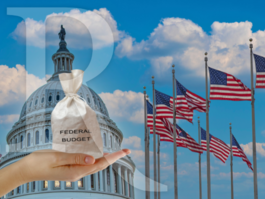50% Expect U.S. Government To Go Bankrupt Before Budget Is Balanced
Voters clearly aren’t confident that their elected officials will wrestle federal spending under control. In fact, many now think the government’s more likely to go belly up.
The latest Rasmussen Reports national telephone survey finds that 50% of Likely U.S. Voters think it’s more likely that the government will go bankrupt and be unable to pay its debt before the federal budget is balanced. Thirty-three percent (33%) believe the budget is more likely to be balanced first. Sixteen percent (16%) are undecided. (To see survey question wording, click here.)
Sixty-four percent (64%) of Republicans and 59% of voters not affiliated with either major political party think a government bankruptcy is more likely than a balanced budget. Fifty-three percent (53%) of Democrats are less pessimistic and expect a balanced budget first.
Political Class voters aren’t worried, however: 71% say a balanced budget will come first. Sixty-three percent (63%) of Mainstream voters, on the other hand, think a government bankruptcy is more likely.
This echoes the voter pessimism – both short- and long-term - found in earlier surveys this year. Just 31% think it is even somewhat likely that President Obama and congressional Republicans will reach an agreement to significantly cut long-term government spending trends before the 2012 elections. Only six percent (6%) say it’s Very Likely.
Just 30% of voters believe it’s even somewhat likely that the federal budget will be balanced again for a single year during their lifetimes. That includes only nine percent (9%) who feel it’s Very Likely.
Voters clearly recognize that government spending has risen over the past decade, and most favor a cap on annual spending increases limited to population growth and inflation. Government spending in the United States has grown faster than the growth of population plus inflation every year but one since 1965. Most of that spending growth resulted from policies enacted while Lyndon Johnson and Richard Nixon were in the White House.
(Want a free daily e-mail update? If it's in the news, it's in our polls). Rasmussen Reports updates are also available on Twitter or Facebook.
The survey of 1,000 Likely Voters was conducted on May 23-24, 2011 by Rasmussen Reports. The margin of sampling error is +/- 3 percentage points with a 95% level of confidence. Field work for all Rasmussen Reports surveys is conducted by Pulse Opinion Research, LLC. See methodology.
Rasmussen Reports is a media company specializing in the collection, publication and distribution of public opinion information.
We conduct public opinion polls on a variety of topics to inform our audience on events in the news and other topics of interest. To ensure editorial control and independence, we pay for the polls ourselves and generate revenue through the sale of subscriptions, sponsorships, and advertising. Nightly polling on politics, business and lifestyle topics provides the content to update the Rasmussen Reports web site many times each day. If it's in the news, it's in our polls. Additionally, the data drives a daily update newsletter and various media outlets across the country.
Some information, including the Rasmussen Reports daily Presidential Tracking Poll and commentaries are available for free to the general public. Subscriptions are available for $4.95 a month or 34.95 a year that provide subscribers with exclusive access to more than 20 stories per week on upcoming elections, consumer confidence, and issues that affect us all. For those who are really into the numbers, Platinum Members can review demographic crosstabs and a full history of our data.
To learn more about our methodology, click here.



